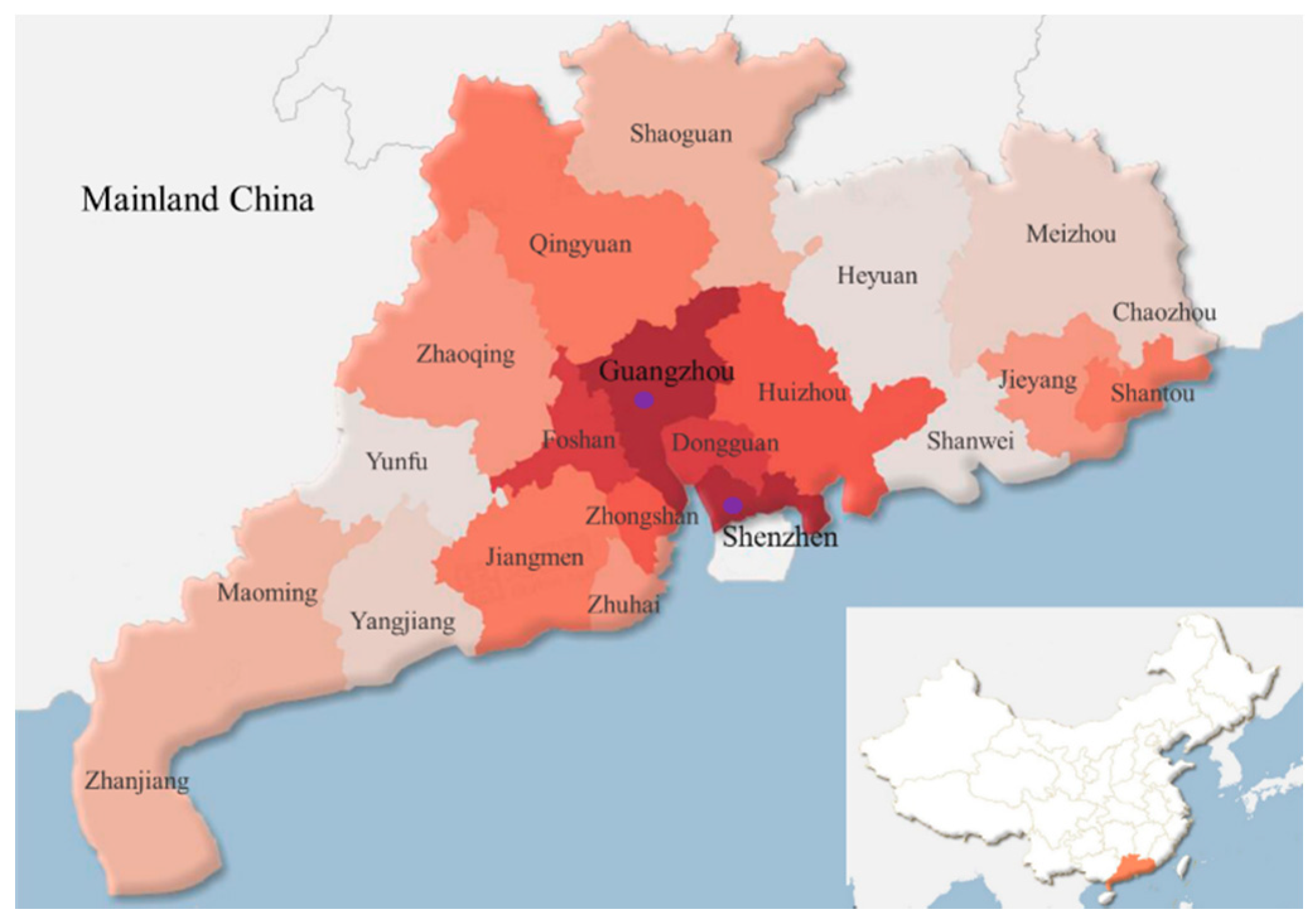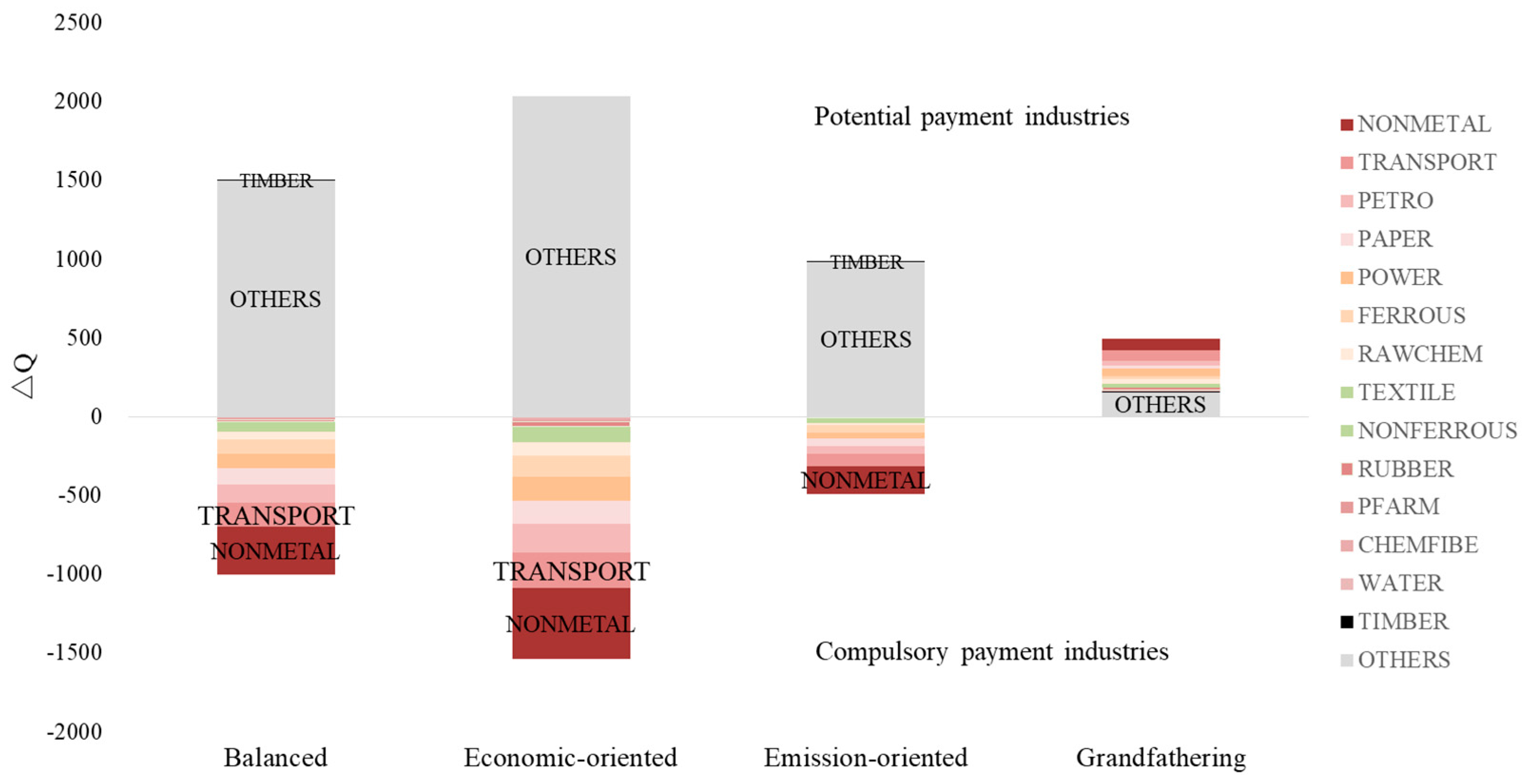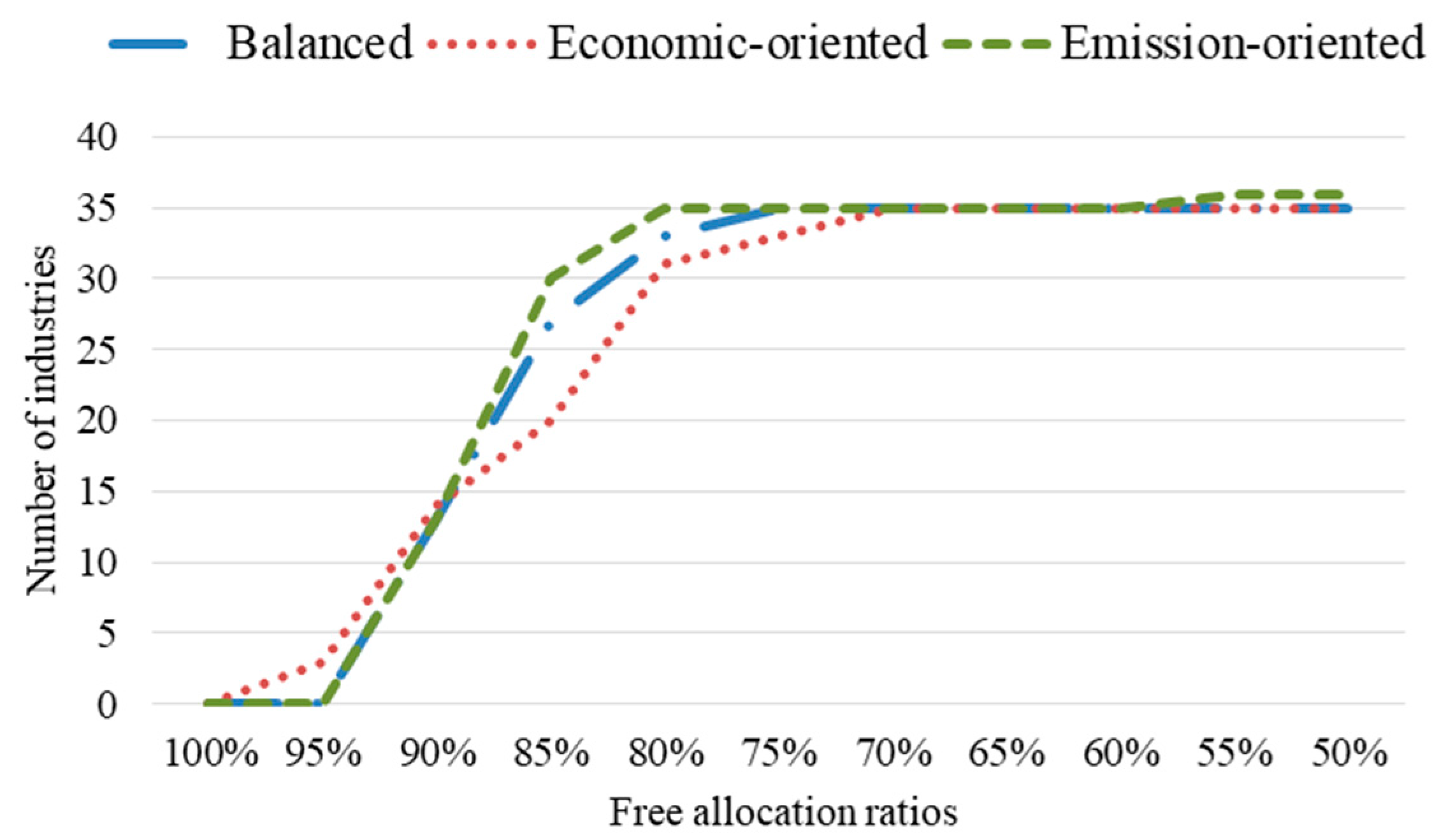3.1. Overview of the Case Study
Guangdong has the jurisdiction of two sub-provincial cities and 19 prefecture-level cities located in the southern coast of mainland China (see
Figure 1). Since 1989, the gross domestic product (GDP) of Guangdong has ranked the first in the country for years, becoming China’s largest economic province and accounting for one-eighth of the national total economic output [
36]. However, there are large development gaps of various industries in Guangdong. For example, in 2015 the industrial added value of communication equipment, computers, and other electronic equipment was 6499.71 one hundred million Yuan, while the figure of chemical fibers was 33.16 one hundred million Yuan [
37]. Moreover, as in China as a whole, the energy structures of both are dominated by coal. In 2015, the proportions of coal, crude oil, and electricity in the primary energy consumption of Guangdong were 42.3%, 27.3%, and 24.0%, respectively [
37].
As a province with the highest economic level, Guangdong owns two pilot ETSs including Guangdong and Shenzhen [
38] and has the largest transaction amount in 2014 [
2]. Moreover, the ETS of Guangdong is characterized by an auction element, which is different from other pilot ETSs in China [
10]. Nonetheless, the proportion of the auction is still low, only 3–5%. Therefore, a reasonable allocation of quotas is of great significance for Guangdong. Based on the above reasons, this paper selects Guangdong as an illustrative case, the empirical results not only assists policy makers of Guangdong in developing new ETS regulations but also provides references for other region’s ETS.
3.2. Data Collection
According to the classification of the
Guangdong Statistical Yearbook 2016, this study regards mining and quarrying as one industry and integrates manufacture of automobile and manufacture of railway, ship, aeronautics and other transport equipment together. The same approach is applied in handicraft and other manufactures, recycling, and disposal of waste and manufacture of metal products, machinery & equipment maintenance. Other industries in the tertiary industry and nonproduction consumption are not covered in this study because they have fewer carbon emissions or do not create GDP. Finally, 36 target industries are obtained, as shown in
Table 1. In addition, the added value data of various industries in 2015 are sourced from
Guangdong Statistical Yearbook 2016.
Since the Chinese government did not report the industries’ carbon emission data directly, this study uses the comprehensive factor method [
11,
39] to calculate the historical carbon emissions of each industry in Guangdong, as shown in Equation (1).
where
and
represent the carbon emissions and total energy consumption of industry
i,
is the carbon emission coefficient of standard coal. China Development and Reform Commission suggests that the carbon content of a unit of standard coal is 67% [
11], which means that per ton of standard coal emits 0.67 tons of carbon, equivalent to 2.457 tons of carbon dioxide (1 × 0.67 × 44/12 = 2.457). Because energy consumption data in Guangdong is now reported in units of standard coal, the main role of the carbon emission coefficient is to convert units from standard coal to carbon dioxide. Finally, energy consumption data of various industries are sourced from
Guangdong Statistical Yearbook 2005–2016.
Remarkably, although Guangdong has published the
Guangdong Statistical Yearbook 2017, implying that the value-added and energy consumption data of various industries in 2016 are available, the main development plan of Guangdong or China (e.g.,
13th Five-Year Plan) is drafted based on the level of 2015. Hence, the data of added value and energy consumption collected in this paper is up to 2015. In accordance with the announcement of the Energy Bureau of Guangdong, the province’s total energy consumption grew 2.3% per year during the
13th Five-Year Plan period [
40]. Therefore, carbon emission quotas and total increment quotas of Guangdong from 2015 to 2020 can be calculated as follows.
where
and
are the total carbon emission quotas of 36 industries of Guangdong in 2020 and 2015, respectively.
3.3. Asymmetric Nash Bargaining Model
As one of the most popular benefit coordination solutions, the traditional Nash bargaining model [
12] is extended to an asymmetric Nash bargaining model [
13] by taking the different bargaining power of each party into consideration, which is shown in Equation (4).
where
is the utility function of the decision maker
,
is the start point of bargaining,
is the bargaining field, and
is the bargaining power of decision maker
and
. The constraint conditions represent that each party’s individual rationality should be ensured.
Borrowing Harsanyi and Selten’s [
13] model, this study can get the following specific Nash bargaining model for the carbon emission quota allocation among 36 industries in Guangdong. To ensure the initiatives of the industries in the negotiation, the carbon emission quotas of each industry through negotiation should be not less than that of before negotiation. The specific model is shown in Equation (5).
where
is the carbon emission quotas of
th industry in 2020;
is actual carbon emissions of
th industry in 2015,
is the total carbon emission quotas of 36 industries of Guangdong in 2020, and
is the bargaining power of
th industry.
Now the problem is to determine the bargaining power of each industry. The present studies have discussed different principles for emissions allocation, such as grandfathering, equity, efficiency and feasibility [
15]. Regarding the carbon emission allocation among industries, Lee et al. [
41] proposed two allocation models, one was based on the level of economic development and the other was based on the level of carbon emissions. However, a single indicator often leads to different or even contradictive allocation results, and thus it is very difficult to reach a consensus among various entities [
8]. Currently, pilot in Guangdong ETSs mainly adopt the grandfathering approach that employs carbon emissions as an indicator. Hence, to overcome the limitation of a single indicator and in accordance with Guangdong’s local political, economic and industrial differences, this study adopts composite indicator approach to calculate the bargaining power of each industry. Both efficiency and feasibility principles are taken into consideration, while GDP and historical carbon emissions, two of the most frequently considered indicators in literature and practice [
8,
10,
15], are selected as proxies for each of the two principles. The reason for joining GDP indicator to form the bargaining power is that the main task of China is still to promote economic development [
38]. Moreover, as the beginning of the
13th Five-Year Plan (2016–2020), the year 2015 is set to be the base year. Therefore, the bargaining power of each industry can be expressed in Equation (6).
where
is the carbon emissions of
th industry in 2015,
is the total carbon emissions of 36 industries of Guangdong in 2015,
is the GDP of
th industry in 2015,
is the total GDP of 36 industries of Guangdong in 2015.
and
are the weights of historical carbon emissions and GDP indicator, respectively, and the sum of them equals one.
Moreover, this study weights each indicator in three preference cases.
Case 1: Balanced weighting. It denotes that the decision maker has no preferences for principles of efficiency and feasibility. The two indicators, GDP and historical carbon emissions, are allocated with equal weight values of 0.5.
Case 2: Economic-oriented weighting. It denotes that the decision maker has a different preference for efficiency and economic development and allocates higher weight to GDP indicator, 0.7, and lower weight to historical carbon emissions indicator, 0.3.
Case 3: Emission-oriented weighting. It denotes that the decision maker has a preference for feasibility and allocates higher weight to historical carbon emissions indicator, 0.7, and lower weight to GDP indicator, 0.3.
The weighting allocations of the three preference cases are shown in
Table 2.
Using MATLAB R2016a to perform the Lagrange multiplier method, this paper applies Mathematical Induction to obtain the solutions of Equation (5), as shown in Equation (7).
Obviously, from Equation (7), it is easy to prove that is an increasing function of its carbon emissions in the base year , the total carbon emissions of 36 industries of Guangdong in 2020 , as well as its bargaining power . In fact, the solutions of Equation (5) can be simplified to . The reason is that the problem in Equation (5) determines as the solution to a mathematical programming problem. Inspection of this problem reveals that the objective is a linear expenditure system utility function. The constraints include , and given that , it is well-known that the lower bounds will be satisfied with strict inequality. Other constraints such as can be regarded as a budget constraint where all the prices have value one. Given these observations, the solutions can be quite simply. Because the percentage error of the above two calculation methods is less than 1%, for simplicity, this study only shows the final allocation results.
Finally, to make a comparison, the results allocated by the grandfathering approach are given by Equation (8):
where
is the carbon emission quotas of industry
by using the grandfathering approach, the year 2015 is set to be the base year.








